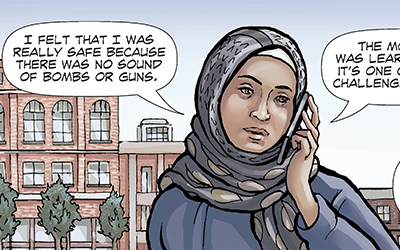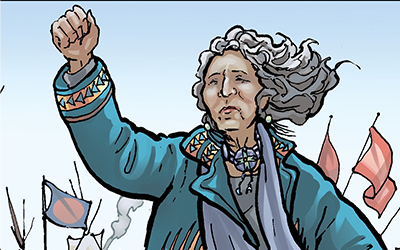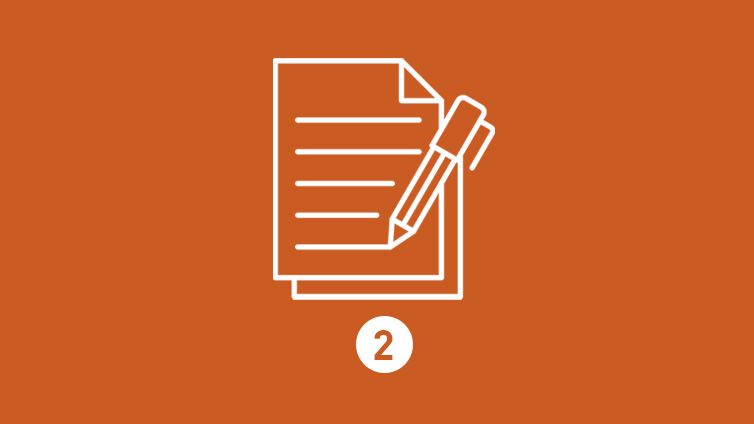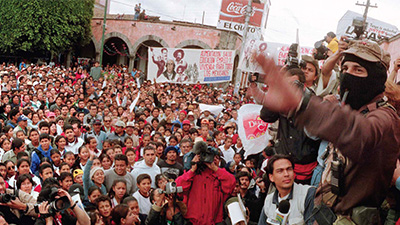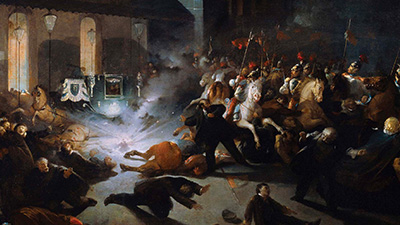Experiencing Globalization
Teacher Resources
Driving Question: What challenges does globalization present to different communities around the world?
From forced migration to cultural resistance, people around the world have responded to globalization in different ways. These stories show how individuals work to protect their rights, identities, and communities.
Learning Objectives:
- Create arguments using historical evidence to support claims and communicate conclusions through informal writing.
- Use evidence to evaluate how different communities experience and respond to globalization.
- Use a graphic biography to support, extend, or challenge the overarching narratives of this period.
Vocab Terms:
- ancestral
- democratization
- desecrated
- migration
- refugee
- terrorism
Opener: Experiencing Globalization
To teach this lesson step, refer to page 2 of the Lesson 9.7 Teaching Guide.
As the world becomes more global, many communities struggle to assert their own identities and preserve their cultural heritage. This excerpt and activity will help you understand how different communities experience globalization.
Forced Migration
To teach this lesson step, refer to page 3 of the Lesson 9.7 Teaching Guide.
Looking for more ideas about how to teach historical comics? Check out the Graphic Biographies Guide.
Globalization has made movement easier for some but has forced it upon others. These materials highlight how refugees and migrants have navigated conflict, borders, and belonging in the modern era.
-
Guiding Questions
-
Before you read
Preview the questions below, and then skim the article. Be sure to look at the section headings and any images.
While you read
Look for answers to these questions:
- Why did antimigrant protests occur in Europe after 2015?
- Which country hosts the most refugees, and what deal did it make with the EU?
- How has nationalism influenced refugee policies?
- How did decolonization contribute to rising refugee numbers?
- Why do some wealthy countries accept migrant labor?
After you read
Respond to this question: How has globalization changed patterns of migration over the past 100 years?
-
Guiding Questions
-
Before you read
Preview the questions below, and then skim the comic, paying attention to things like prominent colors, shapes, and types of text and fonts. How do you know where to start and in which direction to read? What’s in the gutters (the space between panels)? Who or what is the focus of the comic?
While you read
- Why did Islam Alhashel’s family leave their home?
- Where did they first seek refuge, and how did they relocate again?
- What challenges did Islam Alhashel face in the United States?
- How does the artwork show Islam Alhashel’s journey from loss to rebuilding?
After you read
Respond to this question: How does Islam Alhashel’s story support or challenge what you’ve learned about communities experiencing globalization?
Democratization and Islam in Pakistan
To teach this lesson step, refer to page 4 of the Lesson 9.7 Teaching Guide.
Looking for tips on using video in an instructionally sound way? Look no further than the OER Project Video Guide.
Consider how globalization intersects with gender, politics, and religion through the story of Benazir Bhutto—Pakistan’s first female leader and a symbol of both progress and controversy.
-
Guiding Questions
-
Before you watch
Preview the questions below, and then review the transcript.
While you watch
Look for answers to these questions:
- Who was Benazir Bhutto’s father?
- What happened during Bhutto’s first term in office?
- What did Bhutto focus on in her second term?
- Why did Bhutto return to Pakistan in 2007?
- What happened to Bhutto after her return?
After you watch
Respond to these questions: Do you think Bhutto was an effective leader and advocate for women’s rights? What evidence supports your claim?
Key Ideas
Indigenous Resistance
To teach this lesson step, refer to page 5 of the Lesson 9.7 Teaching Guide.
Globalization has often threatened Indigenous culture and sovereignty. These materials explore how Indigenous communities have pushed back by preserving the past and protecting the future.
-
Guiding Questions
-
Before you watch
Preview the questions below, and then review the transcript.
While you watch
Look for answers to these questions:
- Why does Theresa Pasqual say the word ruins is a mistake?
- What access challenges do Pueblo people face today?
- Why does Brian Vallo oppose excavating certain sites?
- What concern does Dr. Swentzell raise about returning remains?
- What are some examples of successful repatriation?
After you watch
Respond to this question: How did this video change the way you think about archaeological or historical evidence?
Key Ideas
-
Guiding Questions
-
Before you read
Preview the questions below, and then skim the comic, paying attention to things like prominent colors, shapes, and types of text and fonts. How do you know where to start and in which direction to read? What’s in the gutters (the space between panels)? Who or what is the focus of the comic?
While you read
- Who was LaDonna Brave Bull Allard?
- Why did the Sioux oppose the Dakota Access Pipeline?
- What historic battle took place in the same area?
- What metaphor did LaDonna Brave Bull Allard use to describe the pipeline?
- How does the artwork reflect LaDonna Brave Bull Allard’s metaphor and the region’s history?
After you read
Respond to this question: Does LaDonna Brave Bull Allard’s story suggest globalization is flat or uneven? Explain your answer.
How Much Has Our World Changed?
To teach this lesson step, refer to page 7 of the Lesson 9.7 Teaching Guide.
Use the CCOT Feedback Form to show students how far they’ve come in learning this skill this school year.
Take a step back and compare what you’ve learned. This activity helps you identify patterns of change and continuity across regions, cultures, and global events.
Closer: Experiencing Globalization
To teach this lesson step, refer to page 10 of the Lesson 9.7 Teaching Guide.
Closers are a great way to assess student learning, and the Unit 9 Notebook is a perfect way to see progress. Read more in the OER Project Assessment Guide.
Globalization can be a complicated topic, but you’ve built your knowledge of it throughout the unit. Let’s dive in and analyze how much your thinking has developed.
Globalization Under Fire
To teach this lesson step, refer to page 10 of the Lesson 9.7 Teaching Guide.
Not all communities embrace globalization. In this step, you'll examine how non-state actors challenge global systems and claim autonomy. These stories add complexity to our understanding of how people experience and react to global change.
-
Guiding Questions
-
Before you read
Preview the questions below, and then skim the article. Be sure to look at the section headings and any images.
While you read
Look for answers to these questions:
- Why did the Zapatistas rise up against the Mexican government in 1994?
- How do the Zapatistas connect their movement to a longer history?
- How did the Mexican government respond to the Zapatistas?
- What community services have the Zapatistas created in Chiapas?
- How do the Zapatistas view globalization?
After you read
Respond to this question: What does the Zapatista movement reveal about the limits of globalization and the continuity of Indigenous resistance?
-
Guiding Questions
-
Before you read
Preview the questions below, and then skim the article. Be sure to look at the section headings and any images.
While you read
Look for answers to these questions:
- What is the main goal of terrorism?
- What is one example of terrorism before the twentieth century?
- What changes in the twentieth century transformed terrorism?
- How was twentieth-century terrorism different from terrorism today?
- How do fear and terrorism operate today?
After you read
Respond to this question: How has terrorism changed because of globalization? Give one example.



